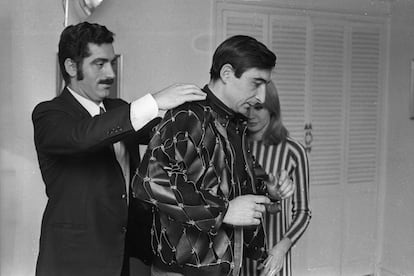Pace-setting designer Paco Rabanne dies at 88
The Spanish-born, Paris-based artist was best known for his fragrances and for dresses that incorporated materials like metal and plastic

Paco Rabanne, the Spanish-born, pace-setting designer known for perfumes sold worldwide and his metallic, space-age fashions, has died at 88. The announcement was made on Friday by the Puig Group, which owns the fashion house.
“I am deeply saddened by the passing of Paco Rabanne. The story of Puig and Paco Rabanne begins in the late 1960s with the launch of Calandre, the perfume created shortly after the designer launched 12 impossible-to-wear dresses in contemporary materials. His great personality conveyed, through a unique aesthetic, his daring, revolutionary and provocative vision of the fashion world. He will remain an important source of inspiration for Puig’s fashion and fragrance teams, who work together to express Paco Rabanne’s radically modern codes. My sincere condolences to his family and those who knew him,” said CEO Marc Puig.
Francisco Rabaneda Cuervo, better known to the world as Paco Rabanne, was born in Pasaia, in Spain’s northern Basque Country, on February 18, 1934. He was the son of an Andalusian general who remained loyal to the Spanish Republic during the Civil War (1936-39) and who was shot in 1937. His mother was Basque and a leading member of the Communist Party of Spain (PCE).
When he was five years old, the family moved to France. After settling in Paris, Rabanne studied architecture at the prestigious Beaux-Arts de Paris and quickly entered the world of fashion because his mother had worked at the Balenciaga fashion studio back in San Sebastián, Spain.

At first, he designed accessories for couturiers such as Givenchy, Balenciaga or Dior. In 1963 he presented his first collection of suits, which incorporated materials such as plastic, paper and aluminum. He went on to create an empire that included haute couture, perfumes and decorative elements. His brand became part of the Spanish group Puig in 1986, but Rabanne and the Puig brand had already been collaborating since 1969, creating a lucrative fragrance market with perfumes such as Paco Rabanne pour Homme and 1 Million.
He was also known for his artistic activities and his forays into philosophical thought. As a result of his particular interpretation of the prophecies of Nostradamus, the Spanish fashion designer famously came to the conclusion that the Mir international space station would fall on the French capital on August 11, 1999.
“Paco Rabanne made transgression magnetic. Who else could induce elegant Parisian women to clamor for dresses made of plastic and metal? Who else but Paco Rabanne could imagine a fragrance called Calandre (whose meaning is ‘automobile grille’) and turn it into an icon of modern femininity? That radical and rebellious spirit distinguished him: there is only one Rabanne. With his passing, we remember once again his enormous influence on contemporary fashion, a spirit that lives on in the Maison that bears his name,” said Jose Manuel Albesa, president of Puig’s beauty and fashion division.
Sign up for our weekly newsletter to get more English-language news coverage from EL PAÍS USA Edition
Tu suscripción se está usando en otro dispositivo
¿Quieres añadir otro usuario a tu suscripción?
Si continúas leyendo en este dispositivo, no se podrá leer en el otro.
FlechaTu suscripción se está usando en otro dispositivo y solo puedes acceder a EL PAÍS desde un dispositivo a la vez.
Si quieres compartir tu cuenta, cambia tu suscripción a la modalidad Premium, así podrás añadir otro usuario. Cada uno accederá con su propia cuenta de email, lo que os permitirá personalizar vuestra experiencia en EL PAÍS.
¿Tienes una suscripción de empresa? Accede aquí para contratar más cuentas.
En el caso de no saber quién está usando tu cuenta, te recomendamos cambiar tu contraseña aquí.
Si decides continuar compartiendo tu cuenta, este mensaje se mostrará en tu dispositivo y en el de la otra persona que está usando tu cuenta de forma indefinida, afectando a tu experiencia de lectura. Puedes consultar aquí los términos y condiciones de la suscripción digital.









































